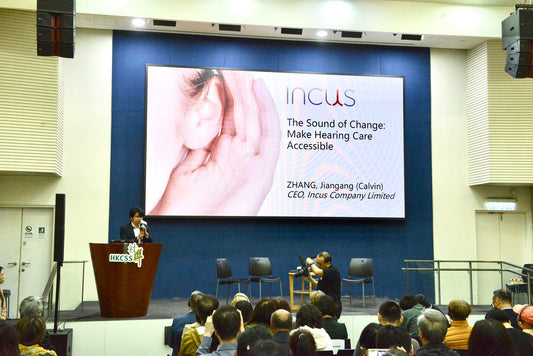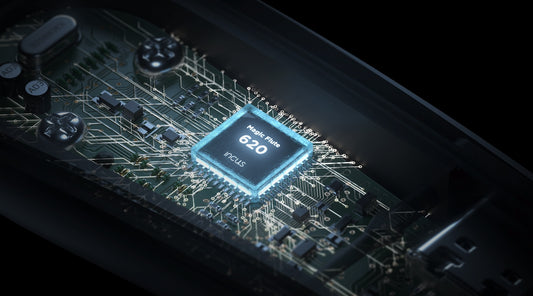
If you have tried hearing aids or been near someone wearing them, you may have heard some whistling or screeching sounds from the devices. If not, you may be familiar with the same effect at venues where there is a microphone and audio playback system set up and suddenly the speakers start producing intolerable screeching or howling noises. This is comparable to when hearing aids whistle.
The Causes of Hearing Aids Whistling

Whistling happens when the sound produced by the loudspeakers is picked up by the microphones, and therefore reproduced by the loudspeakers once more. Again, that sound will be picked up by the microphones. This process continues until the loop is broken.
Why Hearing Aids Are Especially Susceptible to Whistling
Hearing devices are small, so the microphones and loudspeaker are necessarily near each other. Besides, the loudspeakers produce loud sounds to compensate for the wearer’s hearing loss. That is why hearing aids are prone to the feedback effect. This is especially the case if the hearing aids are fitted for someone with severe or profound hearing loss.
Situations Where Hearing Aids Whistle
Whistling occurs when too much sound escapes from the ear canal and reaches the microphones of the hearing aid.
Some situations from our daily lives can cause hearing aids to whistle. Examples include:
- Smiling
- Chewing
- Hugging
- Touching your ear
- Touching or adjusting the hearing device
- Laying down
What these actions have in common is that they affect how the hearing aid sits in the ear canal and allow more sound to escape and reach the microphones.
Other times, whistling happens when the pathway for sound leaving the ear canal is changed, for example when wearing a scarf or a hat, or when holding a mobile phone near the ear. These actions trap or redirect sounds and could lead them to the microphones, resulting in whistling.
If the hearing aid is whistling when on the phone, then try holding it tilted, so that sounds are reflected away from the ear rather than bouncing directly back at the ear.
Hearing aids will often screech when they are being removed from, or inserted into, the ear. To avoid this, one could power on the devices only after they sit securely in the ear, and be mindful of powering them off before removing them from the ear. This is assuming that the devices have a power button. Some hearing aids using replaceable batteries are switched off by opening the battery hatch, which may not be feasible while the device is worn.
Why Some Hearing Aids Whistle All the Time
You might encounter that your hearing aid whistles constantly. This is not normal, so if it happens, you should do something to stop it.
The top causes of feedback in hearing aids are:
- The hearing aid does not fit the wearer’s ear canal size or shape well enough
- The wearer has ear wax buildup
- The hearing device is worn incorrectly
- The hearing aid settings are unsuitable
Whistling could also be caused by any combination of the above.
How To Stop Hearing Aids From Whistling
To break the feedback loop that is causing whistling, one could reduce the volume or in other ways prevent sounds from the loudspeakers leaking out and reaching the microphones.
If the hearing aid whistles frequently, the best bet is to visit the audiologist or hearing aid dispenser and explain the problem. A hearing care professional should be able to identify the causes of whistling and make the changes needed to stop it.
Things they might try include:
- Adjusting the amount of amplification
- Making new earmoulds or finding new ear tips or domes with smaller vent sizes
- Checking whether ear wax buildup is the cause or if the device was worn incorrectly
Throughout this process, the hearing care professional will be mindful of an important balancing act:
How Whistling Is Related to the Occlusion Effect
On one hand, a more closed fit can help reduce the amount of whistling. On the other hand, the more closed the fit is, the more likely it is going to lead to the occlusion effect.
The occlusion effect is when you hear echo-like booming or hollow sounds when you talk, chew or walk, and is caused by low-frequency sounds being unable to escape the ear canal. When people wearing hearing devices complain that their own voice sounds too loud, it is usually because of the occlusion effect.
Ideally, there should be enough venting to avoid the occlusion effect, but not so much that the hearing aids whistle. Besides the physical fit, the wearer’s hearing sensitivity should also be taken into account. By reducing the amount of amplification, whistling can be reduced, but it could also reduce the hearing aid’s ability to help the wearer hear better.
How Elite Acoustic Feedback Cancellation Technology Stops Hearing Aids From Whistling
No hearing aid design is perfect. There will always be scenarios where sound could leak out from the ear canal and reach the sensitive microphones of a hearing device.
Researchers at Incus have developed a solution to stop hearing aids from whistling: elite acoustic feedback cancellation technology.
Using sophisticated digital signal processing (DSP) techniques, they created algorithms to detect the pre-conditions for acoustic feedback and pre-emptively tackle it. Thanks to this technology, hearing device wearers do not have to be anxious about sudden loud screeching sounds. The acoustic feedback cancellation technology is available to experience in the latest Incus hearing device.




